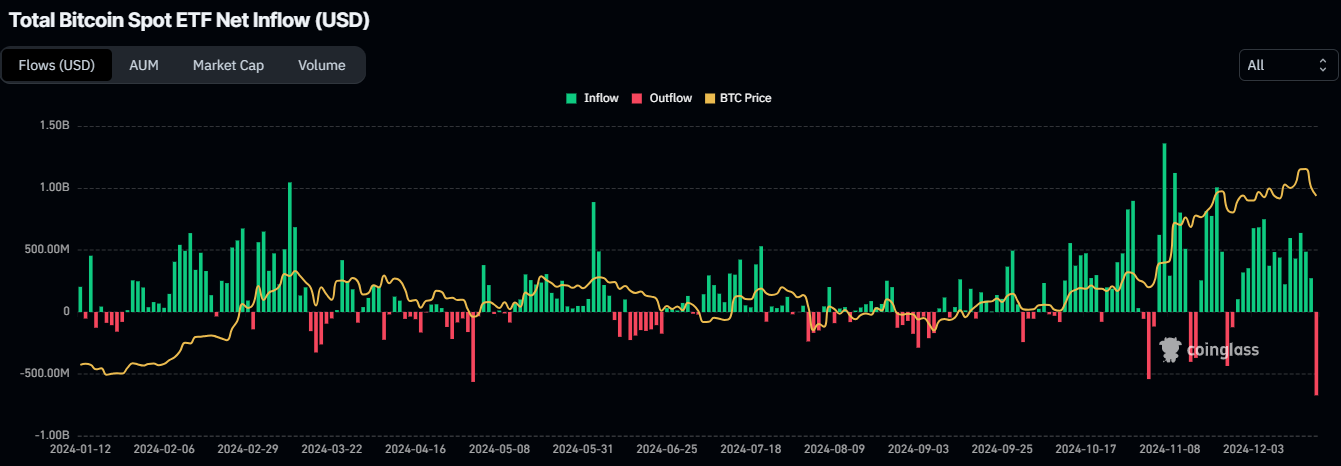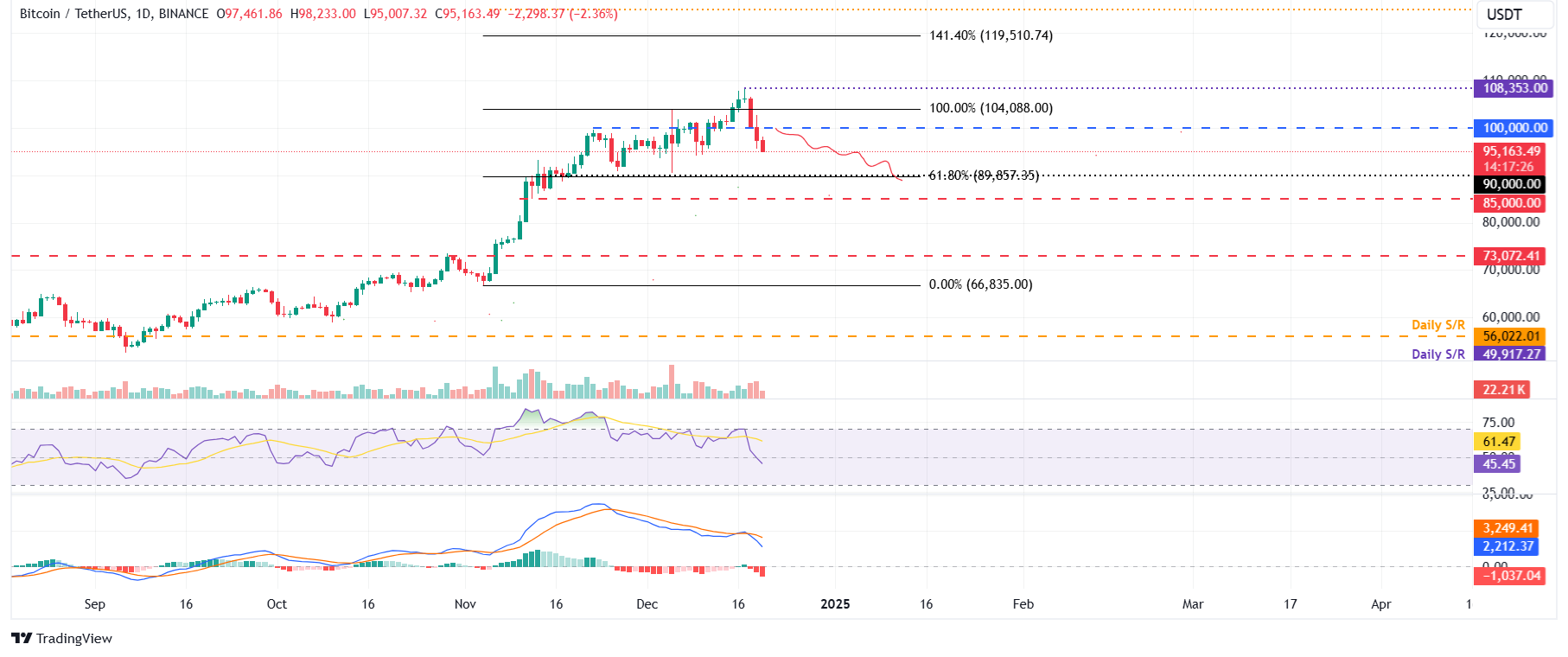Physical Address
304 North Cardinal St.
Dorchester Center, MA 02124
Physical Address
304 North Cardinal St.
Dorchester Center, MA 02124

The price of Bitcoin (BTC) continues to fall, trading below $95,000 on Friday and heading for its worst week since late August. This recent price pullback was fueled by the U.S. Federal Reserve’s (Fed) sharp decision to cut rates on Wednesday, followed by the largest one-day outflow ($671.90) from U.S. spot exchange-traded funds (ETFs) for Bitcoin on Thursday. The technical outlook suggests that the correction will continue, targeting the $90,000 level.
Bitcoin price hit a new all-time high of $108,353 on Tuesday, but failed to sustain its bullish momentum and corrected more than 8% by Thursday. As of Friday, it continues to pull back, trading below $95,000.
Institutional demand showed some signs of weakness this week. According to Coinglass, data on spot exchange-traded funds (ETFs) saw three consecutive days of inflows totaling $759.4 through Wednesday, but saw a massive outflow of $671.90 million on Thursday. The outflow snapped a streak of inflows since November 27 and was the largest one-day outflow since the launch of Bitcoin spot ETFs in January.


Chart of Total Bitcoin Spot ETF Net Inflows. Source: Coinglass
“If I’m a trader and I see ETF inflows starting to slow down, I’d say we’re going to have some weakness,” Eric Turner, CEO of crypto research and data analytics firm Messari, told FXStreet in an exclusive interview.
Turner explained that looking at ETF volumes will be very telling because one of the reasons for smoothing Bitcoin’s volatility is this new source of capital through ETFs.
“We’ve seen some dips recently, but we really haven’t seen what we’ve seen in the past when Bitcoin was down 10% to 20% in one day,” Turner said.
This week’s decline in the price of bitcoin was fueled by the US Federal Reserve’s (Fed) sharp decision to cut rates following Wednesday’s Federal Open Market Committee (FOMC) meeting. As expected, the Fed cut the federal funds rate to a lower range of 4.25% to 4.50%, but signaled a slowdown in rate cuts in 2025, sending risk assets like Bitcoin lower.
Bitcoin’s price correction on Wednesday and Thursday triggered a wave of liquidations, resulting in more than $1.68 billion in total liquidations and more than $371.51 million in BTC alone, according to CoinGlass data.

Total liquidation table. Source: Coinglass

Total Bitcoin Liquidation Chart. Source: Coinglass
In addition to this dire projection, Fed Chairman Jerome Powell has said that the Fed is “not allowed to own Bitcoin.” Powell’s comments indicate that the Fed cannot own Bitcoin and has no intention of changing this policy, which has led to negative reactions in the cryptocurrency.
CEO Messari Turner went on to explain that it is possible for Bitcoin to experience some volatility early in the year and that macroeconomic data and flows into the space primarily through ETFs would be key signs to watch for in the short term.
Business demand for Bitcoin has remained strong despite the price drop this week. Earlier this week on Monday, Michael Salyor’s MicroStrategy (MSTR) announced that the company had purchased an additional 15,350 BTC for about $1.5 billion. MSTR currently holds 439,000 BTC, acquired for $27.1 billion at an average price of $61,725 per Bitcoin.
MicroStrategy acquired 15,350 BTC for ~$1.5 billion at ~$100,386 per #bitcoin and achieved a BTC Yield of 46.4% QTD and 72.4% YTD. From 15.12.2024. we have 439,000 $BTC acquired for ~$27.1 billion at ~$61,725 per bitcoin. $MSTR
— Michael Saylor⚡️ (@saylor) December 16, 2024
During the same period, Riot Platforms also announced that it added 667 BTC at an average price of $101,135 per BTC. Currently, Riot holds 17,429 BTC valued at $1.8 billion.
With additional proceeds from Riot’s $594 million, 0.75% coupon issuance of convertible bonds, the company acquired 667 BTC at an average price of $101,135 per BTC. As a result, Riot increased its holdings to 17,429 BTC, currently valued at $1.8 billion based on… pic.twitter.com/t68Uy8nbHU
— Riot Platforms, Inc. (@RiotPlatforms) December 16, 2024
Marathon Digital (MARA) added 1,627 BTC worth $166 million on Wednesday, according to data from Lookonchain. At the same time, three whale wallets bought 1,153 BTC worth $120 million after the price pullback.
On Thursday, Hut 8 Corp (HUT), an energy infrastructure company and Bitcoin miner, announced that it bought 990 BTC worth $100 million on Wednesday at an average price of $101,710 per Bitcoin. Combined with the Bitcoin before this purchase, Hut 8’s strategic Bitcoin reserve now totals 10,096 BTC with a market value of over $1 billion.
Bitcoin price hit a new all-time high (ATH) of $108,353 on Tuesday and fell 7.8% over the next two days, closing below the $100,000 support level. At the time of writing on Friday, it continues to trade below $95,000.
If BTC continues its correction, it could extend the decline to retest the $90,000 support level.
The relative strength index (RSI) on the daily chart is falling to 45, below its neutral level of 50, and is pointing down, indicating bearish momentum. The Moving Average Divergence (MACD) indicator also showed a bearish transition on Wednesday, indicating an upcoming downtrend.

BTC/USDT Daily Chart
However, if BTC recovers and closes above $100,000, it could extend its climb to retest its all-time high (ATH) of $108,353.
Bitcoin is the largest cryptocurrency by market capitalization, a virtual currency designed to serve as money. This form of payment cannot be controlled by any person, group or entity, which eliminates the need for third-party involvement during financial transactions.
An altcoin is any cryptocurrency except Bitcoin, but some also consider Ethereum a non-altcoin because of the forking of the two cryptocurrencies. If this is true, then Litecoin is the first altcoin, forked from the Bitcoin protocol and, therefore, its “improved” version.
Stablecoins are cryptocurrencies designed to have a stable price, with their value backed by the reserve of assets they represent. To achieve this, the value of any stablecoin is tied to a commodity or financial instrument, such as the US dollar (USD), whose supply is regulated by an algorithm or demand. The main goal of stablecoins is to enable investors willing to trade and invest in cryptocurrencies. Stablecoins also allow investors to store value as cryptocurrencies are generally subject to volatility.
Bitcoin dominance is the ratio of the market capitalization of Bitcoin to the total market capitalization of all cryptocurrencies combined. It provides a clear picture of Bitcoin interest among investors. BTC’s high dominance usually occurs before and during a bull run, in which investors resort to investing in a relatively stable, high market cap cryptocurrency like Bitcoin. A decline in BTC’s dominance usually means that investors move their capital and/or profits into altcoins in search of higher returns, which usually causes an explosion of altcoin growth.